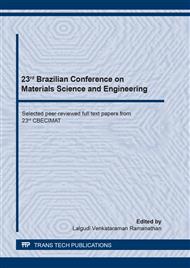[1]
E. Amann, W. Baer, T Trebat, J.V, Lora: The Quart. Rev. Econom. Finan. Vol. 62 (2016), p.66.
Google Scholar
[2]
M.T. Marvila, A.R.G. Azevedo, L.S. Barroso, M.Z. Barbosa, J. de Brito: Construction and Building Materials Vol. 250 (2020), p.118786.
DOI: 10.1016/j.conbuildmat.2020.118786
Google Scholar
[3]
A.R.G. Azevedo, B.R. França, J. Alexandre, M.T. Marvila, E.B. Zanelato, G.C. Xavier: Journal of Building Engineering Vol. 19 (2018) 342.
DOI: 10.1016/j.jobe.2018.05.026
Google Scholar
[4]
C.B. Cheah, L.L. Tiong, E.P. Ng: Const. and Build. Mater. Vol. 202 (2019), p.909.
Google Scholar
[5]
A.N.S. Belattar: J. of Eng. Technol. Vol. 6 (2017), p.139.
Google Scholar
[6]
R.R.J. Ribeiro, H.J.F. Diógenes, M.V. Nóbrega, A.L.H.C. el Debs: Rev. Ibracon Estrut. Mater. Vol. 9 (2016), p.722.
Google Scholar
[7]
S. Alam, S.K. Das, B.H. Rao: J. Clean. Prod. Vol. 168 (2017), p.679.
Google Scholar
[8]
A. Kasmi, N.E. Abriak, M. Benzerzour, H. Azrar: J. of Mater. Cycles Waste Vol. 19 (2017), p.1405.
Google Scholar
[9]
C.D. Zanna, F. Fernandes, J.C. Gasparine: Acta Scient.-Technol. Vol. 39 (2017), p.169.
Google Scholar
[10]
A.R.G. Azevedo, J. Alexandre, M.T. Marvila, G.C. Xavier, S.N. Monteiro, L.G. Pedroti: Journal of Cleaner Production Vol. 249 (2020), p.450.
Google Scholar
[11]
A.R.G. Azevedo, J. Alexandre, G. C. Xavier, F. C. C. França, F. A. Silva, S. N. Monteiro: Materials Science Forum Vol. 20. (2015), p.98.
Google Scholar
[12]
K.G. Nadarason, S. Nagapan, A.H. Abdullah, R. Yunus, N.H. Abas, M.F. Hasmori, K. Vejayakumaran: J. Adv. Res. Dynam. Contr. Systems Vol. 10 (2018), p.281.
Google Scholar
[13]
E. Arifi, K. Ishimatsu, S. Iizasa, T. Namihira, H. Sakamoto, Y. Tachi, H. Kato, M. Shigeishi: Construc. Build. Mater. Vol. 67 (2014), p.192.
DOI: 10.1016/j.conbuildmat.2014.06.001
Google Scholar
[14]
M.R. Ponnada, P. Kamewwar: J. of Adv. Sci. Technol. Vol. 84 (2015), p.19.
Google Scholar
[15]
A.S. Lima, A. Cabral: Eng. Sanitária e Ambiental. Vol. 18 (2013), p.169.
Google Scholar
[16]
National Environment Council (CONAMA), Resolution 307: Estabelece diretrizes, critérios e procedimentos para a gestão dos resíduos da construção civil. Brasília; (2002).
Google Scholar
[17]
National Environment Council (CONAMA). Resolution 308: Licenciamento Ambiental de sistemas de disposição final dos resíduos sólidos urbanos gerados em municípios de pequeno porte. Brasília: National Environment Council; (2002).
DOI: 10.11606/t.6.2012.tde-24042012-092035
Google Scholar
[18]
A.R.G. Azevedo, D. Cecchin, D.F. Carmo, F.C. Silva, C.M.O. Campos, T.G. Shtrucka, S.N. Monteiro: Journal of Materials Research and Technology Vol. 9 (3) (2020), p.5942.
Google Scholar
[19]
Brazilian Association of Technical Standards. Concrete – Procedure for molding and curing concrete test specimens Rio de Janeiro: ABNT 2015. (NBR 5738). (In Portuguese).
Google Scholar
[20]
Brazilian Association of Technical Standards. Concrete – Compression test of cylindrical specimens. Rio de Janeiro: (ABNT) 2018. (NBR 5739) (In Portuguese).
Google Scholar
[21]
Brazilian Association of Technical Standards. Plastic conduit systems for low voltage electrical installations – Performance requirements. Rio de Janeiro: (ABNT) 2008. (NBR 15465). (In Portuguese).
Google Scholar
[22]
Brazilian Association of Technical Standards Concrete. Sampling, preparing, testing and result analysis of concrete cores Part 1: Axial compressive strength. Rio de Janeiro: (ABNT) 2015. (NBR 7680). (In Portuguese).
Google Scholar
[23]
Brazilian Association of Technical Standards. Mortar and concrete – Moist rooms and water tanks for curing. Rio de Janeiro: (ABNT) 2006. (NBR 9479). (In Portuguese).
Google Scholar
[24]
Brazilian Association of Technical Standards. Mortars applied on walls and ceilings - Determination of the consistence index. Rio de Janeiro: (ABNT) 2016. (NBR 13276). (In Portuguese).
Google Scholar
[25]
Brazilian Association of Technical Standards. Mortars applied on walls and ceilings - Determination of the flexural and the compressive strength in the hardened stage. Rio de Janeiro: (ABNT) 2005. (NBR 13279). (In Portuguese).
Google Scholar
[26]
L.F. Amaral, G.C.G. Delaqua, M. Nicolite, M.T. Marvila, A.R.G. Azevedo, J. Alexandre, C.M.F. Vieira, S.N. Monteiro: Journal of Cleaner Production Vol. 248 (2020), p.430.
DOI: 10.1016/j.jclepro.2019.119283
Google Scholar
[27]
E.B. Zanelato, J. Alexandre, A.R.G. Azevedo, M.T. Marvila: Materials and Structures Vol. 52 (3) (2019), p.150.
Google Scholar


